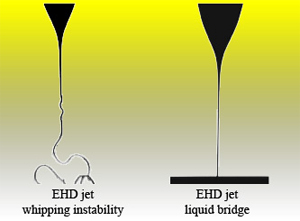 While electronics have become much smaller and more powerful, an elusive goal has been to "print" these tiny devices rapidly over very large areas.While electronics have become much smaller and more powerful, an elusive goal has been to "print" these tiny devices rapidly over very large areas. The ability to do so could lead to larger and less expensive video displays in the near-term and wide-area sensors or medical devices in the longer term. Recently PCCM researchers took a major step in this direction by solving a long-standing problem related to "electrohydrodynamic" (EHD) jets- a liquid stream forced from a nozzle by a very strong electric field. EHD jets are commonly used in industrial painting and fiber spinning, but had the drawback that the liquid stream whips uncontrollably or breaks into droplets. The researchers found what caused the instability and demonstrated a technique for taming it, printing straight lines just 100 nanometers (one-ten thousandth of a millimeter) wide. The method could potentially print at speeds of meters per second.
While electronics have become much smaller and more powerful, an elusive goal has been to "print" these tiny devices rapidly over very large areas.While electronics have become much smaller and more powerful, an elusive goal has been to "print" these tiny devices rapidly over very large areas. The ability to do so could lead to larger and less expensive video displays in the near-term and wide-area sensors or medical devices in the longer term. Recently PCCM researchers took a major step in this direction by solving a long-standing problem related to "electrohydrodynamic" (EHD) jets- a liquid stream forced from a nozzle by a very strong electric field. EHD jets are commonly used in industrial painting and fiber spinning, but had the drawback that the liquid stream whips uncontrollably or breaks into droplets. The researchers found what caused the instability and demonstrated a technique for taming it, printing straight lines just 100 nanometers (one-ten thousandth of a millimeter) wide. The method could potentially print at speeds of meters per second. 
Left: Typical electrodynamic (EHD) jet (dark fluid) becomes unstable and "whips around" after only a short distance. Right: Ionization of the gas surrounding the liquid jet lead to a stable liquid bridge, which can be used to write complex patterns with submicron features.